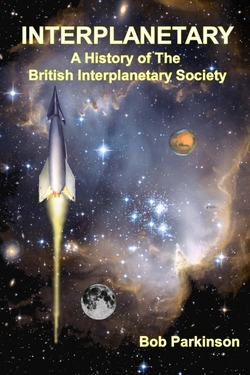Centauri Dreams
Imagining and Planning Interstellar Exploration
Early System Evolution: The Disks around Epsilon Eridani
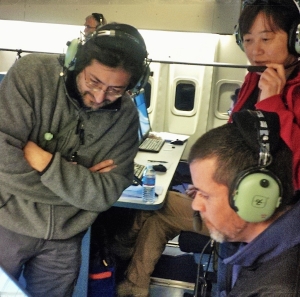
Nine years ago in a piece titled Asteroid Belts, Possible Planets Around Epsilon Eridani, I discussed work that Massimo Marengo was doing on the nearby star, examining rings of material around Epsilon Eridani and considering the possibilities with regard to planets. Marengo (now at Iowa State University) has recently been working with Kate Su (University of Arizona) and other colleagues, using the SOFIA telescope (Stratospheric Observatory for Infrared Astronomy) to help us refine our understanding of the evolving planetary system.
Image: Astronomers (left to right) Massimo Marengo, Andrew Helton and Kate Su study images of epsilon Eridani during their SOFIA mission. Credit: Massimo Marengo.
The researchers used the 2.5-meter telescope aboard the Boeing 747SP jetliner to collect data about the star, working at 45,000 feet in a region above most of the atmospheric water vapor that absorbs the infrared light being studied. Epsilon Eridani is a bit over 10 light years from the Sun, and about a fifth of its age, meaning we have close at hand a stellar system that can help us understand what our own Solar System was like in its youth.
The new paper confirms Marengo’s earlier findings that there are separate inner and outer disk structures, with the possibility that the inner disk is itself made up of more than one debris belt. Says Marengo:
“This star hosts a planetary system currently undergoing the same cataclysmic processes that happened to the solar system in its youth, at the time in which the moon gained most of its craters, Earth acquired the water in its oceans, and the conditions favorable for life on our planet were set.”

Image: This is an artist’s illustration of the Epsilon Eridani system showing Epsilon Eridani b, right foreground, a Jupiter-mass planet orbiting its parent star at the outside edge of an asteroid belt. In the background can be seen another narrow asteroid or comet belt plus an outermost belt similar in size to our Solar System’s Kuiper Belt. The similarity of the structure of the Epsilon Eridani system to our Solar System is remarkable, although Epsilon Eridani is much younger than our sun. SOFIA observations confirmed the existence of the asteroid belt adjacent to the orbit of the Jovian planet. Credit: NASA/SOFIA/Lynette Cook.
This is fine-grained work, for it requires the astronomers to separate the faint emission of Epsilon Eridani’s circumstellar disk from the bright light of the host star. But when Marengo likens the work with SOFIA to using a time machine, he has an obvious point. Debris disks result when belts of planetesimals are perturbed by newly formed planets, creating collisions that over time break the minor bodies down into dust. We know of more than 400 debris disks around other stars, but we have few systems close enough to study at high resolution. Moreover, what the paper describes as the two benchmark nearby debris disks are around A-class stars, Fomalhaut and Vega. Epsilon Eridani gives us a star much more like the Sun.
Debris disks, which can include rocky and icy bodies as well as gas and dust, can be broad, continuous disks or they can become concentrated into belts of debris. Here the analogy is to our own Solar System’s asteroid belt and Kuiper Belt, two distinct regions with one disk of debris concentrated beyond the orbit of Mars and the other beyond the orbit of Neptune. With an outer cold disk and a warm inner one assumed, the new work focuses on the inner disk. Here there are two different models for how the inner disk is formed, with implications for planets.
One model calls for an inner disk made up of two narrow rings of debris, with one ring roughly at the position of our asteroid belt around the star, and the other at a region corresponding to the orbit of Uranus. The other model sees the inner disk region being populated by dust from the outer, Kuiper Belt-like region, with material inflowing into the inner disk. The latter model assumes a single broad disk in the inner system as opposed to two belt-like rings. The new SOFIA observations favor the narrow belt model rather than a broad continuous disk.
Combining data from SOFIA with earlier Spitzer observations, the researchers found that excess emissions in the inner 25 AU region around the star are the result of a dust-producing planetesimal belt, and perhaps more than one. For it turns out that the resolution achieved by the SOFIA data was insufficient to determine whether the inner disk is itself divided into more than one narrow belts, but it did allow the team to rule out the possibility that the inner region’s warm emissions were the result of dust grains pulled in from an outer, much colder belt.
That favors the first model. The paper makes the case that in the absence of dust grains being dragged in from the cold outer belt, a planet might be necessary to explain what is seen in Epsilon Eridani’s inner disk structure. From the paper:
The observed profiles are not consistent with the case dominated by dragged-in grains (uninterrupted dust flow from the cold Kuiper-belt-analog region) as proposed by Reidemeister et al. (2011). This might suggest the need of a planet interior to the 64-au cold belt to maintain the inner dust-free zone, or a very dense cold belt where the intense collisions destroy the dust grains before they have enough time to be dragged in. In either case, some amount of dragged-in grains from the cold belt can still contribute a fraction of the emission inside 25 au; the exact amount remains to be determined by future high spatial resolution.
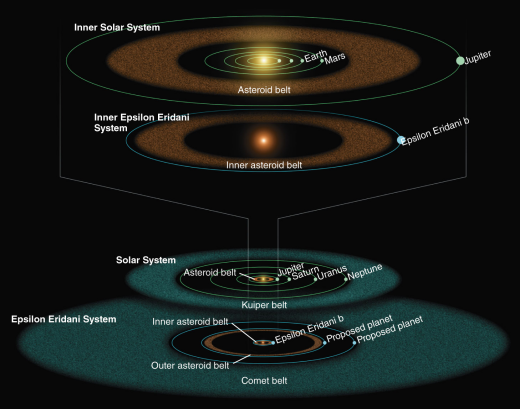
Image: Illustration based on Spitzer observations of the inner and outer parts of the Epsilon Eridani system compared with the corresponding components of our Solar System. Credit: NASA/JPL/Caltech/R. Hurt (SSC).
What we do have, though, is confirmation that we have at least one inner disk, and that it is near the orbit of the Jupiter-class planet that circles the star at a distance comparable to Jupiter’s from the Sun. Kate Su explains:
“The high spatial resolution of SOFIA combined with the unique wavelength coverage and impressive dynamic range of the FORCAST camera allowed us to resolve the warm emission around eps Eri, confirming the model that located the warm material near the Jovian planet’s orbit. Furthermore, a planetary mass object is needed to stop the sheet of dust from the outer zone, similar to Neptune’s role in our solar system. It really is impressive how eps Eri, a much younger version of our solar system, is put together like ours.”
The paper is Su et al., “The Inner 25 AU Debris Distribution in the epsilon Eri System,” Astronomical Journal Vol. 153, No. 5 (25 April 2017). Abstract / preprint.

Cassini: Back into the ‘Big Empty”
Cassini’s final months are stuffed with daring science, the kind of operations you’d never venture early in a mission of this magnitude for fear you’d lose the spacecraft. With the end in sight for Cassini, though, ramping up the science return seems worth the risk. And while diving through the narrow gap between Saturn and its rings seems to be asking for trouble, the results of the first plunge on April 26 show that the region is more dust-free than expected.
“The region between the rings and Saturn is ‘the big empty,’ apparently,” says Cassini Project Manager Earl Maize of NASA’s Jet Propulsion Laboratory in Pasadena, California. “Cassini will stay the course, while the scientists work on the mystery of why the dust level is much lower than expected.”

Image: This artist’s concept shows an over-the-shoulder view of Cassini making one of its Grand Finale dives over Saturn. Credit: NASA/JPL-Caltech.
The region between Saturn and its rings was thought, based on previous models of the ring particle environment, to be free of large particles that could cripple the spacecraft. But it seemed prudent to rotate Cassini so its 4-meter antenna became a ‘bumper’ of sorts that could shield its scientific instrumentation during the dive. Such changes in orientation affect how the spacecraft takes data.
In fact, as we see in this JPL news release, Cassini’s Radio and Plasma Wave Science instrument and its magnetometer were the only two science instruments whose sensors were not in the shadow of the antenna in the first dive. It was the RPWS instrument that measured the particle count during the crossing of the ring plane and found only a few scattered hits.
“It was a bit disorienting — we weren’t hearing what we expected to hear,” says William Kurth, RPWS team lead at the University of Iowa, Iowa City. “I’ve listened to our data from the first dive several times and I can probably count on my hands the number of dust particle impacts I hear.”
Image: This video represents data collected by the Radio and Plasma Wave Science instrument on NASA’s Cassini spacecraft, as it crossed through the gap between Saturn and its rings on April 26, 2017, during the first dive of the mission’s Grand Finale. The instrument is able to record ring particles striking the spacecraft in its data. In the data from this dive, there is virtually no detectable peak in pops and cracks that represent ring particles striking the spacecraft. The lack of discernible pops and cracks indicates the region is largely free of small particles. Credits: NASA/JPL-Caltech/University of Iowa.
The particles the craft did encounter were no more than 1 micron across, about the size of particles you would find in smoke. Now we have another ring plane crossing today at 1538 EDT (1938 UTC), during which Cassini will be out of contact during closest approach to Saturn. We’ll get data return on May 3. After today, 20 ring dives will remain, with four of them passing through the innermost fringes of the rings and demanding the use of the antenna as shield. But the low dust level means that most dives will not need the shield configuration.
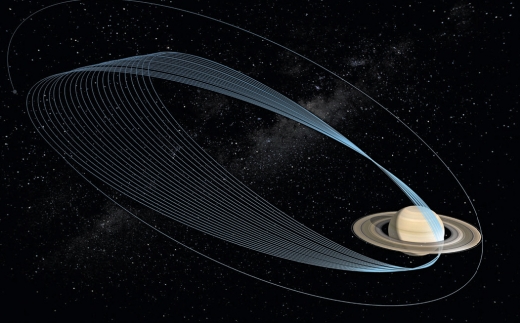
Image: Cassini will perform 22 orbits of Saturn during the Grand Finale. Credit: NASA/JPL-Caltech.
Each of the so-called Grand Finale orbits takes about six and a half days to complete, with the spacecraft’s speed at closest approach to Saturn in each orbit ranging from 35 to 33.6 kilometers per second. This second orbit in the series gives Cassini’s imaging cameras (its Imaging Science Subsystem) a chance to observe the rings at extremely high phase angles while the Sun is directly behind Saturn — this should allow small features like ‘ringlets’ within the rings to be observed. The spacecraft will come within 2930 kilometers of the 1-bar level in Saturn’s atmosphere while passing some 4780 kilometers from the inner edge of the D ring.

NASA Grant Award to Tau Zero Foundation

NASA has awarded a $500,000 grant to the Tau Zero Foundation for a 3-year study titled “Interstellar Propulsion Review.” Unlike prior studies, which were based on a specific mission concept, this study is an overall comparison between the different motivations, challenges, and approaches to interstellar flight. The work is split into three major 1-year phases:
1. Create an interstellar work breakdown structure (WBS) tailored to the divergent challenges and potentially disruptive prospects of interstellar flight in a manner that will allow for ‘level-playing-field’ comparisons. Prior mission and project information will be used to populate this first WBS.
2. Identify and work with subject matter experts to populate the WBS with their most recent reliable data.
3. Analyze uploaded data to identify (1) the most consequential knowledge gaps and (2) recommend research. Once all these phases are completed, the tools and methods are available to repeat the assessments as needed.
Your Inputs Sought
Tau Zero invites the participation of the broader interstellar community to affect this grant, with this call for papers for the next Tennessee Valley Interstellar Workshop (TVIW). This call is in addition to the more general call for abstracts issued from the TVIW hosts, whose topics and conditions can be found here.
Seeding Infrastructure
Many interstellar mission concepts rely on substantial infrastructure in our solar system to build, power, and launch their vehicles. What is seldom addressed, however, is how to begin to build that infrastructure, incrementally and affordably. Abstracts are invited that address that gap, with an emphasis on defining the first infrastructure missions that (a) can be launched with existing spacecraft, (b) provide an immediate utility in space, and (c) are part of a larger plan to extend that capability. This encompasses power production and distribution, mining, construction material processing, in-space construction, and propellant harvesting and delivery.
Exoplanet Science Instruments
What scientific instruments should an interstellar probe carry to collect meaningful information about an exoplanet – information that cannot be obtained from Earth-based astronomy alone? How close would such a probe need to get to an exoplanet to collect this information and how much time will it take within that distance to collect enough data to reach meaningful conclusions? What volume of data would need to be communicated back to Earth? What are projected mass and power requirements for such instrumentation? Abstracts are sought that discuss these instrumentation requirements, characteristics, and the trade-offs between minimizing instrumentation and maximizing information. Papers can be as basic as compiling a list of existing, relevant instrumentation for baseline comparisons, all the way to projections of the minimal mass, power, and computational ability for basic observations. Abstracts are also welcome that discus trends in the abilities of Earth-based exoplanet science and how this affects the instrumentation requirements of interstellar probes.
Foundationally Consistent Baselines
Different mission/vehicle concepts often use different projected performances for common functions such as: (a) heat rejection, (b) energy storage, (c) power management and distribution (PMAD), (d) magnetic nozzles, (e) communication with Earth, (f) equipment longevity, (g) structural mass {if built in space}, and (h) guidance, navigation and control (GNC). Fair comparisons of mission-vehicle concepts are difficult when different values are used for such baseline technologies. Presentations are invited that can credibly delineate reasonable performance estimates for such common functionalities so that future mission-vehicle studies can use common baselines for comparison (e.g. efficiencies, specific masses, readiness levels, etc).
Consistent Comparison Measures
It is difficult to objectively compare different interstellar propulsion and power concepts that use different fundamental methods with method-specific performance measures (e.g. rocket specific impulse, laser pointing accuracy, etc). Abstracts are sought for suggested alternatives to compare both the abilities and resource requirements of diverse interstellar mission concepts – measures that are consistent across all modalities (perhaps in terms of energy, power, mass, mission time, etc.).
Humanities – Interstellar Prerequisite of a Mature Humanity
The energy levels required for interstellar flight are large enough to have the potential to become weapons of mass destruction. Hence, a key prerequisite for achieving interstellar flight is not technical, but societal. Human civilization must mature to where it can wield these energy levels for the greater good instead of on each other. Abstracts are invited that explore these issues in rigorous, academic depth, or suggest how to begin such studies.
Humanities – World Ships as a Crucible of Cultural Study
In addition to the physical life support that has to function reliably for centuries aboard world ships, the culture of the on-board colony will also require a sustainably peaceful governance system along with a culture where the individual citizens live meaningful lives. Abstracts are invited that explore these issues in rigorous, academic depth, or suggest how to begin such studies.
Breakthrough Propulsion Physics
In addition to propulsion and power concepts based on known physics, it is prudent to also consider the possibility that new physics discoveries will lead to breakthrough propulsion, such as faster-than-light transport or propellant-less space drives. Abstracts are sought that identify relevant open questions in physics and then how to further investigate those unknowns. The connection between the open question in physics and its propulsion or power relevance must be explicit. Note, this is not an invitation for new theories or speculations about propulsion devices. Instead, this is a call to identify credible lines of inquiry that might lead to testable, relevant hypotheses. This invitation includes seeking experimental proposals for testing critical relevant questions in physics.
About the Workshop
The TVIW is a scientific and educational association that promotes interstellar exploration, travel, and communications. The TVIW provides an opportunity for relaxed sharing of ideas in directions that will stimulate and encourage interstellar exploration including propulsion, communications, and research. The ‘Workshop’ theme suggests that the direction should go beyond that of a ‘conference’. Attendees are encouraged not only to present intellectual concepts but to develop these concepts to suggest projects, collaboration, active research and mission planning. It should be a time for engaging discussions, thought provoking ideas, and boundless optimism contemplating a future that may one day be within the reach of humanity. Though the TVIW concept was intended to be regional (viz., the American Southeast), it is now, in fact, an internationally recognized event.
Presentation and Publication Requirements
Abstracts should describe content that can be introduced in a 20 minute presentation, followed by 5 minutes for Q&A. Though not a firm requirement, it is desirable that the author prepare a manuscript suitable for submission to a peer-reviewed journal (such as the Journal of the British Interplanetary Society for general papers). The workshop organizers plan to video and stream the presentations, and share the presentation charts with participants.
Submission Requirements
Submit 1-2 page PDF including the following information (file size cannot exceed 3 MB):
– Title
– Presenting author & affiliation.
– Coauthors and respective affiliations.
– Abstract text between 300 to 500 words in length
– Outline for the body of the report
– Cite at least 3 references upon which the work is based
– Cite the most recent publication by the presenting author that relates to the invited topics.
Where to Submit
The Tau Zero specific interests are in addition to a more general call for papers from TVIW. If you are submitting an abstract for the more general coverage of the TVIW, then visit this page. For the Tau Zero specific topics of interest, email your PDF to: Info@TauZero.aero for submissions.
Due Dates
10-May-2017 Submission deadline for TZF Paper Abstracts
31-May-2017 Accepted TZF papers announced
30-Jun-2017 Last day for early registration
30-Sep-2017 Deadline for electronic submittal of all final presentation materials
4-Oct-2017 TVIW 2017 begins
Selections Process
Tau Zero reserves the right to reject any abstract it deems as out of scope or not satisfactorily substantive. It is expected, as a minimum, that abstracts:
– Address the requested topics
– Adhere to the submission requirements
– Reflect that the presentation will be based on sound, credible information instead of speculative or subjective assertions.
Questions can be directed to: Info@TauZero.aero
About Tau Zero
Tau Zero is a 501(c) non-profit organization dedicated to accelerating progress toward the scientific breakthroughs required to support interstellar flight. The Foundation’s efforts, driven by the experts most capable of addressing the formidable challenges of interstellar flight, include fundamental scientific research, encouraging and supporting academic involvement in sciences related to its goals, empowering youth in this quest, forging collaborations for cross-fertilization, and engaging governmental and industry support on a global scale.
Tau Zero’s motto is “Ad Astra Incrementis” – to the stars in ever-expanding steps.
PG Note: To prevent redundancy, I’ve closed comments on this post so that comments can flow to Tau Zero at the address above.

Planetary Discovery around Ultracool Star
I have a special enthusiasm for microlensing as a means of exoplanet discovery. With microlensing, you never know what you’re going to come up with. Transits are easier to detect when the planet is close to its star, and hence transits more frequently. Radial velocity likewise sends its loudest signal when a planet is large and close. Microlensing, detecting the ‘bending’ of light from a background object as it is affected by a nearer star’s gravitational field, can turn up a planet whether near to its star or far, and in a wide range of masses. It can also be used to study planetary populations as distant as the galactic bulge and beyond.
Now we have news of a cold planet about the size of the Earth orbiting what may turn out to be a brown dwarf, and is in any case no more than 7.8 percent the mass of our Sun. Is this an object like TRAPPIST-1, the ultra-cool dwarf star we’ve had so much to say about in recent days as investigations of its 7 planets continue? If so, the planet OGLE-2016-BLG-1195Lb is in no way as interesting from an astrobiological point of view. It’s probably colder than Pluto. It is also the lowest-mass planet ever found using the microlensing technique.
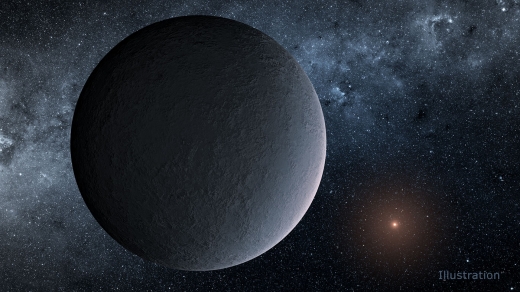
Image: This artist’s concept shows OGLE-2016-BLG-1195Lb, reported in a 2017 study in the Astrophysical Journal Letters. Study authors used the Korea Microlensing Telescope Network (KMTNet), operated by the Korea Astronomy and Space Science Institute, and NASA’s Spitzer Space Telescope, to track the microlensing event and find the planet. Credit: NASA/JPL-Caltech.
But don’t think this frigid world, about 13000 light years away, doesn’t have its uses. It is part of an ongoing investigation into the distribution of planets in the galaxy. The OGLE designation signifies the ground-based Optical Gravitational Lensing Experiment survey, run by the University of Warsaw, which alerted astronomers to the initial microlensing event. The authors of the study on OGLE-2016-BLG-1195Lb then used the Korea Microlensing Telescope Network (KMTNet) as well as the Spitzer space telescope to study the outcome.
With this planet, we are at the lowest end of what microlensing can detect with current methods. We’ll need to get to NASA’s upcoming Wide Field Infrared Survey Telescope (WFIRST) to begin finding smaller bodies than this. Tuning up the method will be useful as we work on understanding how planets are distributed in the Milky Way, since microlensing can find planets at distances far beyond the capabilities of other detection methods. Specifically, will we find a difference in the planet populations of the Milky Way’s central bulge as compared to its disk? OGLE-2016-BLG-1195Lb is a member of the disk population.
“Although we only have a handful of planetary systems with well-determined distances that are this far outside our solar system, the lack of Spitzer detections in the bulge suggests that planets may be less common toward the center of our galaxy than in the disk,” says Geoff Bryden, astronomer at JPL and co-author of the study.
Let’s dig a little deeper, though, into planet formation around ultracool stars. A 2007 paper by Matthew Payne and Giuseppe Lodato looked at the core accretion method of planet formation in the context of very low mass stars and brown dwarfs, arguing that if such objects have protoplanetary disks in the range of several Jupiter masses, then Earth-mass planets should be frequent around them, typically at about 1 AU from the star. But if brown dwarf disks contain less than a Jupiter mass of material, then they probably cannot form a planet.
The OGLE-2016-BLG-1195Lb paper runs through the scholarship, including a 2013 study from Daniel Apai showing that disks occur as frequently around ultracool dwarfs as around Sun-like stars. And a 2016 paper from Leonardo Testi and colleagues found evidence for dusty disks around 11 of 17 young brown dwarfs studied. A Herschel study from Sebastian Daemgen and team, likewise in 2016, found that half of the ultracool dwarf disks it examined were of at least one Jupiter mass.
So we’re making progress at learning about planet formation in ultracool environments, and here again microlensing comes to the fore. Stars this faint, and their even fainter planets, are a tough challenge for most planetary detection methods, though four have been found with direct imaging. Microlensing does not rely on light from the system being studied, but it can give us information about the planetary and stellar masses involved. And indeed, we have four previous microlensing events that have found planets around ultracool dwarfs.
Two of these previous microlensing detections show planets as small as a few Earth masses, and OGLE-2016-BLG-1195Lb lowers the detected mass still further. From the paper:
These [previous discoveries] suggest that the protoplanetary disks of ultracool dwarfs have sufficient mass to form terrestrial planets, as also hinted at by direct imaging of such disks. The location of these planets, at about 1 AU, support planet formation predictions. However, since the sensitivity of current microlensing surveys for systems with such small mass ratios is very narrow, around projected separations of ?1AU, they cannot set strong constraints on the presence of planets elsewhere around ultracool dwarfs, such as the much closer separations seen in the TRAPPIST-1 system.
Small planets may be common around ultracool dwarfs, an idea that previous microlensing discoveries reinforce, along with the work on protoplanetary disks and the seven planets orbiting TRAPPIST-1. As to our expectations regarding planets in the galactic bulge as opposed to the disk, the jury is still out. The planets Spitzer has thus far found in its microlensing campaign for the galactic distribution of planets are all located in the disk. We have two upcoming Spitzer microlensing campaigns, one this year and one next, which should offer additional insights. The key question: Is the galactic bulge deficient in planets?
The paper is Shvartzvald et al., “An Earth-mass Planet in a 1-AU Orbit around an Ultracool Dwarf,” accepted at Astrophysical Journal Letters (preprint).

Cassini Through the Gap
Sometimes it pays to step back and try to look at spaceflight with fresh eyes. Go out and find Saturn in the sky and consider it as the ancients did, a moving celestial ember. And as you stand there, realize all over again that we’ve built a spacecraft that has been operating around that world since 2004, feeding us a datastream as its path was tweaked to look at interesting targets. The sheer magnitude of this accomplishment — Cassini is now operating between the planet and its rings! — is cause for celebration even as the mission’s end approaches.

Image: Artist’s concept of Cassini diving between Saturn and its innermost ring. Credit: NASA/JPL-Caltech/Space Science Institute.
Today’s good news is that controllers have reacquired Cassini’s signals following its plunge through the ring/planet gap on April 26, a time during which its 4-meter high-gain antenna was re-oriented to serve as an ad hoc shield against whatever dust grains or particles might be in its path. Critical maneuvers like these always produce nail-biting moments, and the spacecraft was out of contact during the entire ring-plane crossing, which occurred at 0900 UTC on the 26th, followed by renewed contact with Earth some 22 hours later.

Image: This unprocessed image and the two that follow show features in Saturn’s atmosphere from closer than ever before. These views were captured by NASA’s Cassini spacecraft during its first Grand Finale dive past the planet on April 26, 2017. Credit: NASA/JPL-Caltech/Space Science Institute.
The next dive is scheduled for May 2 in this ‘Grand Finale’ stage of the mission, during which Cassini will make a total of 22 dives, but this first one was obviously crucial in that we have a healthy spacecraft and will obviously learn more about spacecraft protection on future ring-plane crossings. As to that gap between the tenuous upper atmosphere of Saturn and the rings, it’s about 2000 kilometers. With Cassini moving through this area at roughly 34 kilometers per second relative to the planet, any small collisions could knock the craft out of commission.
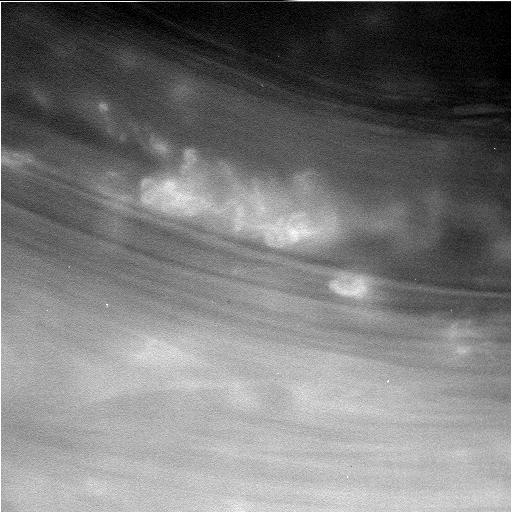
But Cassini made it through. Earl Maize is Cassini project manager at JPL:
“No spacecraft has ever been this close to Saturn before. We could only rely on predictions, based on our experience with Saturn’s other rings, of what we thought this gap between the rings and Saturn would be like. I am delighted to report that Cassini shot through the gap just as we planned and has come out the other side in excellent shape.”
Science and engineering data are now being beamed back to Earth after acquisition of the Cassini signal at the Deep Space Network’s Goldstone Complex in California at 0656 UTC on April 27, with the data flow commencing minutes later. The ring-plane plunge took the spacecraft within 3000 kilometers of the cloud tops, an area where the air pressure is 1 bar, comparable to the atmospheric pressure of Earth at sea level. According to this JPL news release, Cassini also came within 300 kilometers of the innermost visible edge of the rings.

This is a good time to monitor the Cassini raw image gallery. During these ring-plane dives, Cassini will gather data about Saturn’s gravity and magnetic fields, helping us gain a better understanding of the planet’s internal structure. We’ll begin to get our closest ever imagery of the rings and atmospheric clouds even as the spacecraft’s particle detectors sample ring particles being drawn into the atmosphere. And at the end, when Cassini makes its plunge into Saturn itself, we’ll gain measurements of the atmosphere until contact is lost.
We’ve had 13 years at Saturn, and if you wonder why we can’t just keep them going, the fact is that the spacecraft is running out of the fuel needed to adjust its course. Eventually, we’d lose the ability to keep Cassini away from interesting astrobiological targets like Enceladus and Titan, with the subsequent danger of contamination. The Grand Finale maneuvers seek to draw maximum information out of Cassini’s final days before a spectacular finish.

Speculations on Habitable Zone Waterworlds
What to make of Fergus Simpson’s new paper on waterworlds, suggesting that most habitable zone planets are of this type? If such worlds are common, we may find that most planets in the habitable zones of their stars are capable of evolving life, but unlikely to host technological civilizations. An explanation for the so-called ‘Fermi Paradox’? Possibly, but there are all kinds of things that could account for our inability to see other civilizations, most of them covered by Stephen Webb in his If the Universe Is Teeming with Aliens … Where Is Everybody? (2nd ed., Springer 2015), which offers 75 solutions to the problem.
Simpson (University of Barcelona) makes his case in the pages of Monthly Notices of the Royal Astronomical Society, arguing that the balance maintained by a planetary surface with large amounts of both land and water is delicate. The author’s Bayesian statistical analysis suggests that most planets are dominated either by water or land, most likely water. Earth may, then, be something of an outlier, with most planets over 90 percent covered in water.
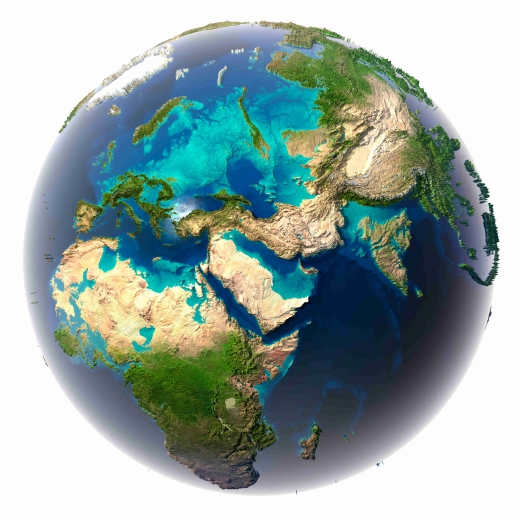
Image: Continents on other habitable worlds may struggle to break above sea level, like much of Europe in this illustration, representing Earth with an estimated 80% ocean coverage. © Antartis / Depositphotos.com.
The unlikelihood of a planet maintaining a balance like the Earth’s gives the paper its direction. Simpson offers a pedagogical example of the Bayesian approach:
…imagine that you look at a kitchen worktop and notice some spilled coffee granules. One of those granules, selected at random, is found to lie within 0.1?mm from the edge of the 600?mm worktop. This proximity could of course be entirely coincidental. But it is much more likely that the bulk of the granules fell on the floor, and what you are seeing is merely the tail end of the distribution.
Is planet Earth at the tail end of the distribution? We don’t have enough exoplanet data to know. But the statistical model here does take note of what we have learned in our explorations of the outer Solar System. Think of Titan, where Stanley Dermott and Carl Sagan predicted in 1995 that instead of a surface covered in extensive ocean, the lack of circularization of the moon’s orbit from oceanic tidal effects pointed to a largely dry surface. We now know that the duo was correct: Titan’s liquid hydrocarbons account for about 1 percent of the total surface area.
Simpson finds this a remarkable call, but he adds that the prediction could have been made even without orbital data on Titan. Let me quote him on this, as it reiterates his method:
On a purely statistical basis, and in the absence of correlations, one expects the division of liquid and solid surface areas to be highly asymmetric. This is because the volume of liquid need not match the capacity of perturbations in the solid. The two quantities often differ by several orders of magnitude. If it is the liquid that dominates, the solid surface becomes completely immersed. Enceladus and Europa offer exemplary cases of this phenomenon. Beneath each of their icy crusts, a single ocean completely envelops a solid core (Kivelson et al. 2000; Waite et al. 2009). If, on the other hand, the liquid’s volume is subdominant, it settles into small disconnected regions, as was found to be the case on the surface of Titan.
To put this in context, we need to consider the delivery of water from icy objects originating beyond the snow line. Here we have to assume a huge variety of outcomes, planets in the habitable zone with a wide variation in the amount of water delivered to the surface. What happens over time? Some water will be found in the mantle, some lost through the upper atmosphere. Planetary topography shapes the distribution of resulting oceans.
The author goes on to consider feedback mechanisms including erosion and soil deposition as well as the deep water cycle by way of placing what happened on Earth in context. Across the galaxy, trillions of dice have been rolled, comments Simpson, and what we would like to know is whether the dice somehow favor a balance between land and water. He thinks not.
Here the anthropic principle weighs in. Does our Earth have the particular balance of water and land we see because planets without this balance — desert worlds or waterworlds — would produce intelligent land-based species at a much lower rate? In other words, if we did not live in a place with this fine-tuned balance, we wouldn’t be observers, something we should keep in mind as we consider the prevalence of worlds like our own. We can also assume that planets with larger habitable areas are more capable of sustaining larger populations. These factors imply to Simpson that the Earth has a greater habitable area than most life-bearing worlds.
We see a planet that could not be otherwise for us to be here, and assume other habitable zone worlds are similar. Our planet, argues the author, is itself close to the waterworld limit, and the water mass fraction among habitable planets could be a good deal higher. From the paper:
…numerical simulations based on delivering water from planetary embryos found a median water mass fractions of approximately 1?per?cent (Raymond et al. 2007), 10 times higher than the terrestrial value. Extremely elevated water compositions have been associated with the inflation of planetary radii (Thomas & Madhusudhan 2016). This scenario, in which the Earth is among the driest habitable planets, could help explain the appearance of a low-mass transition in the mass–radius relation of exoplanets (Rogers 2015; Chen & Kipping 2017).
And if it turns out that the Earth is unusually dry for a habitable zone planet, various mechanisms can explain the result. It is possible that low eccentricities and inclinations of planetary orbits in our Solar System make for less effective water delivery. Perhaps water delivery was affected by migration of the gas giants (Simpson considers the ‘Grand Tack’ model in which Jupiter reversed its migration, but points out that this might also produce a higher rate of water delivery). Or perhaps we have a drier Earth simply because of the stochastic nature of the delivery of water. The trillions of dice throws gave us the numbers we live with and take to be commonplace. We can hardly, then, take the Earth as the norm.
71 percent of Earth is covered by water. In addition to the amount of water delivered (and the mechanisms of that delivery), we have to factor in where it will be stored, how ocean and mantle interact, and how topographical features affect water distribution. Life has been able to emerge and technological civilization take hold because all these factors prevent the planet from becoming a waterworld, a fine balance, says Simpson, that most habitable zone worlds lack.
Simpson’s paper is an intriguing read and one that should provide fodder for science fiction scenarios (I consider that all to the good), but it’s highly speculative given that our models of water delivery in the early Solar System are still works in progress. What we come back to again and again is the need for observation. In the Titan reference Simpson makes early in the paper, it was data that proved the point made by Dermott and Sagan, and data that are required to put such factors as the depth of Earth’s water basins in a cosmic context. So we can keep waterworld theories in mind as we begin studying the actual atmospheric content of exoplanets within coming decades, when new space- and ground-based resources come online.
The paper is Simpson, “Bayesian evidence for the prevalence of waterworlds,” Monthly Notices of the Royal Astronomical Society 468 (3) (2017), 2803-2815 (full text). Thanks to Phil Tynan for an early pointer to this paper.

